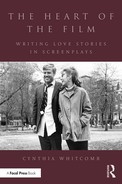Chapter 38
The First Golden Age: 1938–1942
Today if you want to get a great education on how to write love stories for film, and you can’t get into film school, or can’t afford one, don’t worry. You can read a book like this one, and screen the best films at home at your own pace. Silent movies were a separate type of creation with Charlie Chaplin leading on the comedy side and Rudolph Valentino on the drama. Around ten years after movies started talking in 1927, we came upon a golden age of movie love stories. A group of writers, directors, and actors came into their prime and gave us many of the greatest love stories ever filmed in half a dozen years. 1938 to 1943 to be exact.
Those years contained Gone With the Wind, Casablanca, Ninotchka, Camille, The Shop Around the Corner, The Lady Eve, Sullivan’s Travels, The Palm Beach Story, Holiday, The Philadelphia Story, Goodbye, Mr. Chips, Bringing Up Baby, Adventures of Robin Hood, Wuthering Heights, Jane Eyre, In Name Only, Dark Victory, Rebecca, Mr. Smith Goes to Washington, His Girl Friday, My Favorite Wife, Pygmalion, Made For Each Other, and these are just the love stories.
These years also gave us The Wizard of Oz, The Women, Boys Town, Jezebel, The Lady Vanishes, Grand Illusion, Snow White, Stanley and Livingstone, Elizabeth and Essex, Of Mice and Men, Grapes of Wrath, The Hunchback of Notre Dame, Boom Town, Drums Along the Mohawk, Dr. Jekyll and Mr. Hyde, Golden Boy, Destry Rides Again, Abe Lincoln in Illinois, The Adventures of Sherlock Holmes, Babes in Arms, Bachelor Mother, Beau Geste, Our Town, You Can’t Take it With You, and Pinocchio.
The movie stars in their prime in these years? Alphabetically:
- Jean Arthur
- Fred Astaire
- Humphrey Bogart
- Claudette Colbert
- Ronald Coleman
- Gary Cooper
- Joan Crawford
- Bette Davis
- Marlene Dietrich
- Robert Donat
- Henry Fonda
- Joan Fontaine
- Clark Gable
- Greta Garbo
- Judy Garland
- Greer Garson
- Cary GrantOlivia de Havilland
- Katharine Hepburn
- William Holden
- Charles Laughton
- Vivien Leigh
- Carole Lombard
- Raymond Massey
- Joel McCrea
- David Niven
- Merle Oberon
- Maureen O’Hara
- Laurence Olivier
- Ginger Rogers
- Rosalind Russell
- Barbara Stanwyck
- Jimmy Stewart
- Spencer Tracy
- Orson Welles
- Loretta Young
If you want a do-it-yourself graduate film school course, get a hold of the following writers and directors and watch their films. Focusing on the great love stories, dramatic or comedic, here they are:
Ernst Lubitsch
His films were luminously shot in black and white and seemed to glow with luxury and beauty. This is where folks beaten down by the Great Depression could go for a few cents and feel like millionaires for a couple of hours. From Design for Living in 1933, through Ninotchka (1939) in which Garbo laughed, to The Shop Around the Corner (1940, Jimmy Stewart and Margaret Sullavan), To Be or Not to Be (1942, Jack Benny and Carole Lombard), and Heaven Can Wait (1943.) Lubitsch’s touch, once seen, is unmistakable.
Preston Sturges
He gave us 20th Century, Thirty Day Princess, Easy Living, Remember the Night, The Great McGinty, Christmas in July, The Lady Eve, Sullivan’s Travels, The Palm Beach Story, and The Miracle of Morgan’s Creek all in the decade from 1934–44. My favorite screwball comedy of all time is Sturges’s Palm Beach Story. Hilarious, gorgeous, sexy, and touching. The perfect madcap mashup. Joel McCrea, Claudette Colbert, Rudy Vallee, and Mary Astor. If you only watch one movie you get from this book, make it this one. You’re welcome.
Billy Wilder
The director was also a screenwriter with his partner I.A.L. Diamond. His list of love stories is award laden and world class. Starting in 1933 with Ninotchka (Garbo and Melvyn Douglas), Ball of Fire (1941, Barbara Stanwyck and Gary Cooper), Double Indemnity (1944, Stanwyck and Fred MacMurray), The Bishop’s Wife (1947, Loretta Young, Cary Grant, and David Niven), Sunset Boulevard (1950, Gloria Swanson and William Holden), Sabrina (1954, Holden again with Humphrey Bogart and Audrey Hepburn), The Seven Year Itch (1955, Marilyn Monroe), Love in the Afternoon (1957, Gary Cooper and Audrey Hepburn), Some Like it Hot (1959, Jack Lemmon, Tony Curtis, and Monroe), The Apartment (1960, Lemmon again with Shirley MacLaine), and Irma La Douce (1963). Billy Wilder’s contribution to the history of cinema in those thirty years is obviously substantial. If you chose a week and watched a Billy Wilder movie every night, you’d come out a better writer by the end of it. I’m just saying.
The Screwball Comedies
If you want to do a class in Screwball, I’ll give you a required viewing list. This is a sub-genre of love stories that are featherweight, powered by champagne fizziness, peopled with ditzy dames and hapless fellows. The top ten according to the author (alphabetically):
- Arsenic and Old Lace
- The Awful Truth
- Ball of Fire
- Bringing Up Baby
- His Girl Friday
- It Happened One Night
- The Lady Eve
- The More the Merrier
- My Man Godfrey
- The Palm Beach Story
